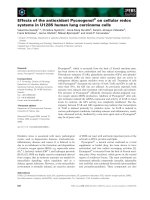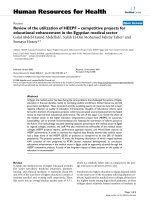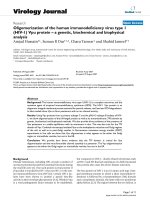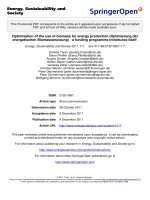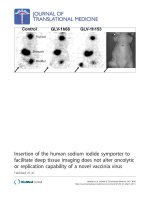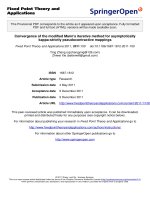Báo cáo sinh học: " Effects of selection for early and late reproduction in low and high larval density populations of the bean weevil" pdf
Bạn đang xem bản rút gọn của tài liệu. Xem và tải ngay bản đầy đủ của tài liệu tại đây (707.82 KB, 14 trang )
Original
article
Effects
of
selection
for
early
and
late
reproduction
in
low
and
high
larval
density
populations
of
the
bean
weevil
(Acanthoscelides
obtectus)
I
Gliksman
N
Tuci&jadnr;
University
of
Belgrade,
Institute
for
Biological
Research
and
Faculty
of
Science,
Yugoslavia
(Received
25
May
1990;
accepted
30
November
1990)
Summary -
This
study
concerns
an
analysis
of
one-generation
selection
for
early
and
late
reproduction
in
populations
maintained
for
10
generations
at
low
and
high
levels
of
larval
density.
We
have
obtained
direct
responses
to
selection
in
both
the
early
and
late
reproducing
parents.
There
was,
however,
no
correlation
between
fecundity
and
longevity.
Phenotypic
responses
suggest
that
parental
age
could
change
the
fecundity
schedule
in
the
way
predicted
by
antagonistic
pleiotropy
theory.
However,
the
absence
of
statistically
detectable
negative
genetic
correlation
between
early
and
late
fecundities
made
our
study
inconclusive
with
respect
to
possible
genetically
based
trade-off
among
fecundity
indices.
Acanthoscelides
obtectus
/
larval
density
/
parental
age
effect
/
fitness
components
Résumé -
Effets
de
la
sélection
pour
une
reproduction
précoce
et
tardive
dans
des
populations
de
bruche
du
haricot
(Acanthoscelides
obtectus)
à
haute
et
faible
densité
larvaire.
Cette
étude
concerne
l’analyse
d’une
génération
de
sélection
pour
une
reproduction
précoce
ou
tardive
de
populations
maintenues
pendant
10
générations
à
une
densité
larvaire
faible
ou
élevée.
Nous
avons
obtenu
des
réponses
directes
à
la
sélection,
chez
les
parents
à
reproduction
précoce
et
à
reproduction
tardive.
Il
n’y
avait
cependant
pas
de
corrélation
entre
la
fécondité
et
la
longévité.
Les
réponses
phénotypiques
suggèrent
que
l’âge
des
parents
pourrait
modifier
l’évolution
de
la
fécondité
au
cours
de
la
vie
comme
le
prédit
la
théorie
de la
pléiotropie
antagoniste.
Cependant,
l’absence
de
corrélation
négative
statistiquement
détectable
entre
les
fécondités
précoces
et
tardives
ne
nous
permet
pas
de
conclure
quant
à
des
oppositions
de
nature
génétique
entre
ces
2 fécondités.
Acanthoscelides
obtectus
/
densité
larvaire
/
âge
des
parents
/
valeur
adaptative
*
Correspondence
and
reprints:
N
Tuci6,
Institute
of
Zoology,
Faculty
of
Science,
PO
Box
550,
Studentski
trg
16,
11000
Belgrade,
Yugoslavia
INTRODUCTION
Since
natural
selection
operates
on
several
traits
simultaneously
the
optimal
life
his-
tory
has
been
seen
as
&dquo;the
best
compromise
given
a
set
of
options&dquo;
(Sibly
and
Calow,
1986).
Starting
from
this
point,
a
great
deal of
the
theory
of
life
history
evolution
(see
eg
Charlesworth,
1980;
Reznick,
1985;
Scheiner
et
al,
1989)
is
based
on
the
assumption
of
&dquo;trade-offs&dquo;
or
negative
genetic
pleiotropy
among
life
history
fitness
components
(fitness
components
are
largely
synonymous
with
life
history
parame-
ters;
see
eg
Istock,
1983).
For
example,
according
to
the
best-known
evolutionary
theory
of
senescence
(Williams,
1957),
senescence
is
envisaged
most
accurately
as
a
by-product
of
genes
with
pleiotropic
effects
on
the
fitness
components,
such
that
increases
early
in
the
life
span
in
one
set
of
fitness
components
are
accompanied
by
decreases
in
other
fitness
components
later
in
life.
Despite
the
central
position
of
antagonistic
pleiotropy
in
life
history
theory,
experimental
demonstrations
of
genetic
trade-offs
were
until
very
recently
almost
absent.
Several
recent
studies
(eg
Rose
and
Charlesworth,
1981a,
b;
Rose,
1984;
Luckinbill
et
al,
1984;
Tucié
et
al,
1988)
have
provided
evidence
of
negative
genetic
correlations
among
traits
at
early
and
late
stages
of
life
history.
However,
Giesel
et
al
(1982),
Stearns
(1983),
Mitchell-Olds
(1986)
and
Engstrom
et
al
(1989),
for
example,
found
no
evidence
of
negative
genetic
correlations
among
fitness
components.
Independently
of
any
mechanism
of
genetic
control
proposed,
the
fundamental
question
of
the
evolutionary
theory
of
senescence
is
&dquo;how
do
long
and
short
life
spans
evolve?&dquo;
(Luckinbill
and
Clare,
1985).
Having
in
mind
the
suggestion
provided
by
MacArthur
and
Wilson
(1967)
that
density
dependent
selection
could
be
responsible
for
much
of
the
observed
diversity
of
life
history
strategies
among
taxa,
Luckinbill
and
Clare
(1985)
used
2
experimental
treatments
of
larval
density
in
a
long-term
selection
study
for
increased
longevity
of
Drosophila
melanogaster.
By
selecting
for
late
reproduction
when
larval
density
was
held
low,
they
were
unable
to
detect
a
significant
increase
in
longevity.
However,
populations
with
high
and
uncontrolled
numbers
of
the
developing
larvae
responded
strongly
to
selection
for
late
reproduction,
with
the
longevity
increasing
by
?
50%.
Thus
Luckinbill
and
Clare
demonstrated,
showing
that
the
larval
environment
could
alter
the
expression
of
genes
for
adult
longevity,
existence
of
genetic
variation
for
sensitivity
of
fitness
to
density.
Service
et
al
(1988)
have
corroborated
these
findings.
Indeed,
low
rearing
density
seems
to
reduce
response
to
selection
for
increased
longevity
in
Drosophila
populations.
Motivated
by
these
studies
on
Drosophila,
as
surprisingly
little
experimental
work
on
genetic
variation
for
response
to
conspecific
density
exists,
we
conducted
an
experiment
to
examine
the
phenotypic
and
genetic
responses
in
bean
weevil
(Acanthoscelides
obtectus)
life
history
traits
that
occur
when
density
dependent
selection
is
acting.
Specifically,
in
this
paper
we
present
the
results
of
a
study
of
one-generation
selection
for
early
and
late
reproduction
in
populations
maintained
for
10
generations
at
low
and
high
levels
of
larval
density.
MATERIALS
AND
METHODS
Life
history
of Acanthoscelides
obtectus
The
bean
weevil,
Acanthoscelides
obtectus
(Say),
is
a
well
known
leguminous-feeding
beetle
of
the
family
Bruchidae
(Coleoptera).
The
females
lay
eggs
on
the
surface
of
host
seeds.
The
eggs
hatch,
and
the
first
instar
larvae
bore
into
the
seed
where
they
feed.
The
final
instar
larvae
excavate
a
chamber
just
below
the
seed
testa,
and
the
presence
of
a
larva
may
be
detected
by
a
small
&dquo;window&dquo;.
Pupation
occurs
in
this
chamber
and
adults
must
chew
a
hole
through
the
testa
in
order
to
emerge.
Larval
stages
feed
entirely
within
a
single
seed.
Competition
among
larvae
in
overcrowded
circumstances
can
be
severe;
from
a
single
bean
seed
(about
20
mm
sized)
as
many
as
45
adults
can
emerge
(personal
observation).
The
adults
do
not
require
to
feed
in
order
to
mate
and
oviposit.
This
feature
(non-feeding
adults)
of
the
bean
weevil
life
history
is
particularly
attractive
for
the
analysis
of
genetic
trade-offs
since
adults
have
a
finite
amount
of
resource
that
may
be
allocated
between
fecundity
and
maintenance.
The
population
used
here
was
&dquo;synthetic&dquo;,
originating
from
different
local
populations
of
Yugoslavia.
It
was
maintained
in
culture :
3
yr
prior
to
these
experiments.
In
all
experiments
Phaseolv,s
vulgaris
cv
&dquo;gradistanac&dquo;
beans
were
used.
The
size
of
all
seeds
used
in
the
present
experiment
was !
20
mm.
All
the
beans
were
brought
in
bulk
at
one
time
from
one
source.
Density
dependent
selection
The
following
summarizes
the
method
of
selection
used
to
obtain
the
low
density,
high
density
and
control
populations.
The
low
density
regime
was
designed
to
be
uncrowded
for
the
developing
larvae.
At
the
start
of
this
treatment,
320
beetles
were
chosen
randomly
from
the
base
population
and
reared
in
10
separate
bottles
with
100
bean
seeds
(ie each
bottle
contained
32
weevils
whose
sex
ratio
has
been
determined
by
chance).
After
!
3
wk
these
bottles
were
monitored
daily
until
the
first
eclosion
of
adults
began
(the
eclosion
is
recognized
by
getting
&dquo;windows&dquo;
black;
otherwise
windows
at
the
seed
testa
are
grey).
At
that
time
beans
with
1
to
3
windows
(which
indicate
low
larval
density)
were
separated.
Since
the
probability
of larvae
from
same
bean
being
sibs
is
higher
when
the
number
of
larvae
per
bean
is
small
(which
could
cause
inbreeding
depression
over
generations)
we
employed
the
following
procedure.
Beans
with
low
larval
density
from
all
10
bottles
were
kept
together
in
a
single
bottle.
The
seeds
with
higher
larval
density
were
discarded.
From
the
newly
emerged
adults
(usually !
1000
individuals),
in
the
batch
of
low
larval
density
seeds
we
chose,
again
randomly,
10
groups
with
32
beetles,
in
order
to
establish
a
new
generation.
This
procedure
was
repeated
for
10
generations.
A
high
density
population
was
maintained
under
high
larval
density.
The
procedure
and
propagule
size
(ie
32
beetles
per
bottle)
were
as
described
above,
except
that
new
generations
were
founded
from
beans
containing
10-20
(rarely
more).windows.
Thus,
the
only
difference
between
the
2
selection
regimes
was
the
higher
degree
of
larval
crowding
in
the
high
density
population.
In
the
control
treatment
we
did
not
control
larval
density.
In
all
other
aspects
the
experimental
procedures
were
identical
to
those
in
the
previous
2
treatments.
Analysis
of
the
parental
age
effects
After
10
generations
200
pairs
of
beetles
were
chosen
randomly
from
each
treatment.
Individual
females
were
put
into
separate
Petri
dishes
containing
3
beans
and
an
unrelated
male,
for
oviposition.
These
Petri
dishes
were
checked
daily.
Upon
death
of
the
female,
her
life
span
and
daily
fecundity
were
recorded.
In
order
to
demonstrate
parental
age
effects
in
the
population
selected
for
different
larval
density,
the
following
1-generation
artificial
selection
for
age-specific
modification
of
fecundity
was
imposed.
This
selection
proceeded
by
choosing
the
females
with
highest
3-day
fecundity
record,
from
1-3
as
the
&dquo;young&dquo;
parents,
and
from
7-10
as
the
&dquo;old&dquo;
parents.
According
to
our
previous
results
(Tuci6
et
al,
1990)
these
2
periods
are
the
most
convenient
for
analysing
age-specific
pattern
of
reproduction
in
the
non-feeding
bean
weevils.
Thus,
within
the
population
selected
for
different
larval
densities,
the
experiments
were
designed
to
enforce
an
early
versus
late
age-specific
pattern
of
reproduction.
The
best
25%
of
females
laying
were
chosen.
However,
for
late
reproduction
more
intense
selection
was
imposed
(!
15%
of
females
laying
were
chosen
as
the
parents)
because
of
the
low
fecundity
of
the
old
females
or
some
other
reason.
Daily
fecundity
was
measured
on
4
newly
emerged
adult
females,
chosen
at
random
from
each
selected
female,
in
separate
Petri
dishes
with
3
bean
seeds
and
a
male
sib.
The
number
of
beetles
which
died
was
counted
every
day.
Upon
death
of
the
female,
her
longevity
and
different
fecundity
indices
have
been
recorded.
We
chose
the
following
indices
of
fecundity:
egg-laying
d
1-3,
egg-laying
d
7-9,
egg-
laying
d
10
or
more;
total
fecundity
(over
life
span),
first
day
of
egg
laying,
last
day
of
egg
laying,
age
of
peak
fecundity
and
laying
rate
(total
fecundity/last
day
of
egg
laying).
All
cultures
were
maintained
in
an
incubator
at
30°C
and !
70%
humidity.
Experimental
adults
were
subjected
to
starvation.
Narrow
sense
heritability
for
each
trait
was
estimated
by
regression
analysis
of
mean
offspring
values
and
maternal
values
(Falconer,
1981).
In
general,
it
is
desirable
to
regress
offspring
values
of
the
male
parents,
because
the
estimated
covariance
between
mother
and
offspring
can
be
inflated
by
maternal
effects.
Unfortunately,
regression
on
male
parent
is
impossible
here
because
we
analysed
age-specific
fecundity
pattern
in
females.
Thus,
the
confounding
of
maternal
and
genetic
covariance
in
the
parent-offspring
regression
is
unavoidable.
In
addition,
broad
sense
heritability
was
also
calculated
using
a
least
squares
analysis
of
variance
model
(Sokal
and
Rohlf,
1981).
RESULTS
In
table
I
the
means
and
standard
errors
of
different
life
history
traits
for
each
density
selected
population
in
the
first
generation
of
reproduction
at
young
or
old
age
are
given.
For
each
trait
pairwise
comparisons
between
means
were
made
using
Tukey’s
test.
The
high
larval
density
population
for
both
parental
ages
shows
lower
average
longevity
relative
to
the
corresponding
parental
age
in
the
low
density
groups,
as
well
as
in
control
populations.
These
differences
are
significant
at
the
0.01
level
in
all
but
1
case
(low
density,
young
parents vs
high
density,
old
parents).
In
all
other
cases
the
differences
between
average
longevities
are
insignificant.
In
the
high
larval
density
population
all
fecundity
indices,
except
the
fecundity
7-9
days,
were
significantly
different
between
the
offspring
of
the
young
and
old
parents.
However,
when
the
same
comparisons
are
made
within
low
density
or
control
populations,
the
picture
which
emerges
is
quite
different.
Here
Tukey’s
test
has
shown
that
fecundity
indices
of
the
differently
aged
parents,
except
for
the
first
day
of
laying
within
the
low
density
population,
are
not
detectably
different
from
each
other
(table
I).
All
the
other
comparisons
show
that
fecundity
indices
of
the
young
parent
offspring
in
the
high
density
population
are
most
frequently
statistically
different
from
the
other
treatment.
It
is
worth
considering
the
effect
of
larval
density
on
the
longevity
and
fecun-
dity
irrespective
of
the
parental
age.
Table
II
compares
the
means
of
these
life
history
traits,
obtained
after
pooling
of
early
and
late-reproduced
parents
within
populations
with
low
and
high
larval
densities.
The
average
longevity,
fecundity
>
10
d,
last
d
of
egg
laying,
age
of
peak
fecundity
and
laying
rate
were
higher
in
the
low
density
population
than
in
the
high
density
population.
In
all
above
cases
the
differences
between
traits
at
low
and
high
density
were
significant,
as
shown
by
the
t-test.
The
observed
pattern
among
life
history
traits,
for
weevils
selected
for
different
larval
density,
is
quite
opposite
to
that
predicted
by
r-
and
K-selection
regimes
(see
Pianka,
1970).
An
outcome
such
as
we
obtained
is
expected
in
models
of
life
history
in
which
the
effects
of variable
environment
are
relatively
greater
on
mortality
of
juveniles
than
adults.
Stearns
(1976)
discusses
these
predictions
under
the
heading
of
&dquo;bet-hedging&dquo;.
It
seems
from
table
I
that
parental
age
at
the
time
of
reproduction
can
also
affect
the
analysed
traits.
To
test
for
significance
between
early
and
late-reproduced
parents,
taking
simultaneously
into
account
the
effects
of
larval
density,
a
2-way
analysis
of
variance
was
made
(since
we
had
an
unbalanced
data
set,
we
used
the
method
described
in
Steel
and
Torrie,
1960).
The
results
of
such
an
analysis
of
variance
for
longevity
and
different
fecundity
indices
are
presented
in
table
III.
In
all
these
cases
there
was
a
small,
statistically
insignificant
&dquo;parental
age
x
density&dquo;
interaction,
suggesting
that these
2
variables
are
largely
independent
in
moulding
the
observed
pattern
among
analysed
traits.
Interestingly
enough,
the
effects
of
parental
age
and
population
density
on
longevity
and
fecundity
seem
to
be
different.
For
all
fecundity
indices
we
found
significant
influence
of
parental
age
(table
III).
Significant
effects
of
larval
density
have been
found
for
longevity,
as
well
as
for
several
fecundity
indices
(see
table
III).
Figure
1
shows
the
overall
pattern
of
survivorships
in
different
treatments.
In
order
to
compare
different
survivorship
curves
we
have
employed
the
test
suggested
by
Rose
(1984).
This
test
is
based
on
the
comparison
of
mortality
rates.
Concerning
mortality
rate
differences
there
are
2
hypotheses
to
test.
First,
statistical
significance
of
the
average
mortality
rate
differences
between
paired
groups.
Second,
analysis
of
trend
with
respect
to
age
in
mortality
rate
differences.
The
raw
data
for
testing
both
hypotheses
have
been
obtained
as
follows:
(1),
age
specific
mortality
rates
were
calculated
for
each
of
5
4-d
intervals,
from
d
1
to
d
20
of
the
assay
(after
d
20
there
were
too
few
individuals);
(2),
mortality
rate
differences
between
the
paired
groups
have
been
divided
by
the
total
mortality
rate
in
that
age-interval;
(3),
the
obtained
data
were
then
used
to
calculate
the
mean
mortality
rate
differences
between
paired
groups.
Through
each
pair’s
mortality
rate
data
the
least
square
linear
regression
was
calculated
as
well.
None
of
the
estimated
average
mortality
rate
differences
between
any
pair
of
compared
populations
is
significantly
different
from
zero.
In
addition,
except
for
the
comparison
within
control
population
(between
offspring
of
young
and
old
parents)
there
is
no
apparent
age
specificity
in
mortality
rate
differences
between
compared
groups.
(Space
considerations
preclude
the
detailed
presentation
of
these
results,
but
they
are
available
from
the
senior
author.)
The
overall
patterns
of
the
mean
daily
fecundity
in
all
treatments
are
shown
in
figure
2.
Although
there
is
no
appropriate
statistical
test
for
the
entire
fecundity
pattern,
it
seems
that
postponement
in
reproductive
output
is
present
in
the
offspring
of
old
relative
to
young
parents
in
all
treatments.
The
magnitudes
of
the
actual
responses
to
one-generation
selection
for
early
and
late
fecundity
in
terms
of
the
intensity
of
selection
(i),
selection
differentials
(S),
selection
response
(R)
and
realized
heritability
(h
2)
are
given
in
table
IV.
The
change
in
the
expected
phenotypic
value
in
offspring
as
a result
of
one-generation
selection
that
chiefly
interests
us
here
is
the
realized
heritability.
The
patterns
for
both
traits
(early
and
late
fecundities)
suggest
that
realized
heritabilities
are
greater
in
the
high
density
population.
A
comparison
of
realized
heritabilities
between
early
and
late
reproduced
groups
indicates
that
realized
heritabilities
are
higher
for
early
fecundity
in
all
experimental
populations.
Narrow
and
broad
sense
heritability
estimates
for
longevity
and
fecundity
data
for
early
reproduced
weevils
within
each
population
are
given
in
table
V.
The
heritabilities
for
late
reproduced
parents
have
been
omitted,
since
a
valid
estimation
of
genetic
variation
with
a
small
number
of
families
(here
10-16
per
population)
is
not
possible.
Only
2
traits,
both
within the
low
density
population,
showed
significant
narrow
sense
heritabilities
(table
V).
Among
all
full-sib
estimates
of
heritability
7
were
significantly
different
from
zero.
Genetical
variation
is
a
necessary
prerequisite
for
the
existence
of
genetic
correlation
between
different
traits.
Since
we
found
no
significant
heritabilities
in
most
analysed
traits,
there
was
a
small
possibility
of
finding
a
significant
genetic
correlation
among
them.
Nevertheless,
we
calculated
the
additive
genetic
correlation
matrix
(by
means
of
the
parental-offspring
regression
method;
see
Falconer,
1981)
traits
for
offspring
of
young
parents
within
each
of
3
populations.
As
predicted,
none
of the
estimated
correlations
are
significantly
different
from
zero
(for
this
reason
we
omitted
their
presentation,
but
they
are
available
from
the
authors).
DISCUSSION
According
to
Luckinbill
and
Clare
(1985)
specific
change
in
the
external
environ-
ment
during
preadult
stages
(ie
high
larval
density)
and
the
internal
environment
during
adult
stages
(ie
reproduction
at
the
later
stages)
give
rise
to
increased
longevity
in
Drosophila
melanogaster.
The
results
of
long-term
selection
for
de-
layed
senescence
obtained
by
Rose
and
Charlesworth
(1981b),
Rose
(1984),
Mueller
(1987)
and
Service
et
al
(1988),
also
with
D
melanogaster,
are
in
qualitative
accord
with
the
above-cited
expectation
regarding
the
effects
of
parental
age
and
larval
density.
It
is
to
be
expected,
therefore,
that
1-generation
selection
for
late
repro-
duction
in
a
population
selected
10
generations
for
high
larval
density
will
show
higher
longevity
relative
to
a
population
selected
for
low
larval
density
and
early
reproduction.
In
this
experimental
design
with
the
bean
weevil,
Acanthoscelides
obtectus,
we,
however,
have
not
been
successful
in
detecting
significant
response
to
combined
effects
of
late
parental
age
and
high
larval
density
with
respect
to
adult
longevity
(table
I).
In
fact,
we
have
obtained
only
direct
responses
to
1-generation
selection
in
both
early
and
late
reproducing
parents
(table
IV).
However,
there
was
no
correlation
between
the
fecundity
responses
and
longevity.
Though
the
average
longevities
in
late
reproduced
parents
suggest
some
enhancement
in
longevity,
the
overall
effects
of
this
treatment
do
not
reveal
significant
differences
(table
III).
Finally,
mortality
rate
differences
between
treatments
were
not
observed
either.
The
outcome
of
our
previous
study
with
the
bean
weevil
(Tuci6
et
al,
1990),
in
which
long-term
selection
for
early
and
late
reproduction
was
imposed,
has
been
consistent
with
the
present
results.
Moreover,
these
findings
are
in
agreement
with
the
observation
of
Moller
et
al
(1989),
who
found
a
similar
relationship
between
longevity
and
fecundity
in
another
weevil
species,
Calosobruchus
maculatu,s.
The
absence
of
the
direct
link
between
fecundity
and
longevity
in
our
experiments
implies,
therefore,
that
differences
in
fecundity
of
the
bean
weevils
need
not
involve
genes
with
pleiotropic
effects
on
longevity.
Though
quantitative
genetic
analyses
seem
futile
when
selection
experiments
fail
to
detect
a
cost
of
reproduction
trade-off,
we
have
found,
at
least,
2
reasons
for
such
analyses.
First,
besides
the
predictive
value,
analyses
of
the
genetic
variation
and
covariation
among
fitness
traits
have
important
descriptive
value.
Second,
and
of
more
interest
in
the
present
context,
there
is
a
possibility
that
observed
trade-
offs
between
early
and
late
fecundity
have
a
genetic
basis.
Indeed,
the
results
in
tables
I
and
III
suggest
that
parental
age
could
really
change
the
fecundity
schedule
in
the
way
predicted
by
antagonistic
pleiotropy
theory
(ie
that
offspring
of
the
young
parents
have
higher
early
fecundity
than
offspring
of
the
old
parents,
and
vice
versa).
But
the
absence
of
statistically
detectable
negative
correlations
between
early
and
late
fecundities
made
our
study
inconclusive
with
respect
to
the
possible
genetically
based
trade-off
among
fecundity
indices.
There
is
another
argument
against
antagonistic
pleiotropy
between
early
and
late
fecundity.
Having
in
mind
our
selection
regimes,
it
is
very
likely
that
offspring
of
the
young
parents
lack
some
genetic
variants,
increasing
the
late
reproduction,
which
are
present
in
offspring
of
the
old
parents.
Similarly,
the
high
late
reproduction
in
offspring
of
the
old
parents
would
not
be
causally
related
to
their
low
early
reproduction
effort
(Partridge,
1987,
has
used
the
same
arguments
against
negative
genetic
pleiotropy
in
the
interpretation
of the
above-cited
long
term
selection
studies
with
Drosophila).
Hence,
the
simplest
interpretation
of
our
results
is
in
terms
of
phenotypic
plasticity
for
longevity
and
fecundity.
It
means
that
every
bean
weevil
female
may
face
a
phenotypic
(physiological)
trade-off
in
the
allocation
of
limited
resources
between
fecundity
and
longevity,
but
in
the
absence
of
genetic
variation
in
this
allocation,
the
genetical
trade-off
is
undetectable
by
long-term
selection
experiments
or
by
genetical
analyses.
We
could
say
then
that
differences
between
individuals
are
based
on
phenotypic
plasticity
(which
is
a
short-term,
contingent
response
of
an
individual
to
immediate
circumstances
which
may
increase
fitness),
and
a
genetical
trade-off
need
not
exist.
ACKNOWLEDGMENTS
We
thank
D
Marinkovic
and
the
anonymous
reviewers
for
their
helpful
suggestions
and
comments
on
the
manuscript.
REFERENCES
Charlesworth
B
(1980)
Evolution
in
Age-Structured
Populations.
Cambridge
Univ
Press,
Cambridge
Engstrom
G,
Liljedahl
EL,
Rasmuson
M,
Bjorklund
T
(1989)
Expression
of
genetic
and
environmental
variation
during
ageing.
I.
Estimation
of
variance
components
for
number
of
adult
offspring
in
Drosophila
melanogaster.
Theor
Appl
Genet
77,
119-122
Falconer
DS
(1981)
Introduction
to
Quantitative
Genetics.
Longman,
London
Giesel
JT,
Murphy
PA,
Manlove
MN
(1982)
The
influence
of
temperature
on
genetic
interrelationships
of
life
history
traits
in
a
population
of
Drosophila
melanogaster.
What
tangled
data
sets
we
weave.
Am
Nat
119, 464-479
Istock
CA
(1983)
The
extent
and
consequences
of
heritable
variation
for fitness
characters.
In:
Population
Biology,
Retrospect
and
Prospect
(King
CE,
Dawson
PS,
eds)
Columbia
University
Press,
New
York
Luckinbill
LS,
Arking
M,
Clare
MJ,
Cirocco
WC,
Buck
SA
(1984)
Selection
for
delayed
senescence
in
Drosophila
melanogaster.
Evolution
38,
996-1003
Luckinbill
LS,
Clare
M
(1985)
Selection
for
life
span
in
Drosophila
Taelanogaster.
Heredity
55,
9-18
McArthur
RH,
Wilson
EO
(1967)
The
Theory
of
Island
Biogeography.
Princeton
University
Press,
Princeton,
NJ
Mitchell-Olds
T
(1986)
Quantitative
genetics
of
survival
and
growth
in
Impatiens
capensis.
Evolution 40,
107-116
Møller
H,
Smith
RH,
Sibly
RM
(1989)
Evolutionary
demography
of a bruchid
beetle.
I.
Quantitative
genetical
analysis
of
the
female
life
history.
Funct
Ecol
3,
673-681
Mueller
LD
(1987)
Evolution
of
accelerated
senescence
in
laboratory
populations
of
Drosophila.
Proc
Natl
Acad
Sci
USA
84,
1974-1977
Partridge
L
(1987)
Is
accelerated
senescence
a
cost
of
reproduction?
Funct
Ecol 1,
317-320
Pianka
ER
(1970)
On
r-
and
K-selection.
Am
Nat
104,
592-597
Reznick
D
(1985)
Cost
of
reproduction:
an
evaluation
of
the
empirical
evidence.
Oikos
44,
257-267
Rose
MR
(1984)
Laboratory
evolution
of
postponed
senescence
in
Drosophila
melanogaster.
Evolution
38,
1004-1010
Rose
MR,
Charlesworth
B
(1981a)
Genetics
of
life
history
in
Drosophila
melano-
gaster.
I.
Sib
analysis
of
adult
females.
Genetics
97,
187-196
Rose
MR,
Charlesworth
B
(1981b)
Genetics
of
life
history
in
Drosophila
melano-
gaster.
II.
Exploratory
selection
experiments.
Genetics
97,
187-196
Scheiner
SM,
Caplan
RL,
Lyman
RF
(1989)
A
search
for
trade-offs
among
life
history
traits
in
Drosophila
melanogaster.
Evol
Eco13,
51-63
Service
PM,
Hutchinson
EW,
Rose
MR
(1988)
Multiple
genetic
mechanisms
for
the
evolution
of
senescence
in
Drosophila
melanogaster.
Evolution
42,
708-716
-
’e, !
* lqr
’**&dquo;
I
Sibl
y
RM,
Calow
P (1986) P/t!s!0!o!!ca<
Ecology
of
Animals:
An
Evolutionary
Approach.
Blackwell
Sci
Publ,
Oxford
Sokal
RR,
Rohlf FJ
(1981)
Biometry.
Freeman,
San
Francisco,
CA
Stearns
SC
(1976)
Life-history
tactics:
a
review
of
the
ideas.
Q
Rev
Biol
51,
3-47
Stearns
SC
(1983)
The
genetic
basis
of
differences
in
life
history
traits
among
six
populations
of mosquitofish
(Gambusia
afJinis)
that
shared
ancestors
in
1905.
Evolution
37,
618-627
Steel
RGD,
Torrie
JH
(1960)
Principles
and
Procedures
of
Statistics.
MacGraw-Hill,
NY
Tuci6
N,
Cvetkovi6
D,
Milanovi6
D
(1988)
The
genetic
variation
and
covariation
among
fitness
components
in
Drosophila
melanogaster
females
and
males.
Heredity
60,
55-60
Tuci6
N,
Cvetkovi6
D,
Stojiljkovi6
V,
Bejakovi6
D
(1990)
The
effects
of
selection
for
early
and
late
reproduction
on
fecundity
and
longevity
in
bean
weevil
(Acan-
thoscelides
obtectus).
Genetica
80,
221-227
Williams
GC
(1957)
Pleiotropy,
natural
selection
and
the
evolution
of
senescence.
Evolution
11,
398-411

